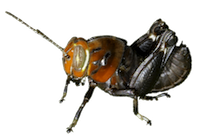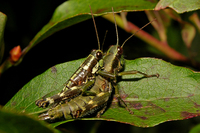Family (Alpha): ACRIDIDAE GRYLLACRIDIDAE GRYLLIDAE GRYLLOTALPIDAE RHAPHIDOPHORIDAE ROMALEIDAE TETRIGIDAE TETTIGONIIDAE TRIDACTYLIDAE
View Acrididae Members:
Metaleptea brevicornis Schistocerca alutacea Schistocerca americana Schistocerca damnifica Schistocerca lineata Schistocerca obscura Schistocerca rubiginosa Amblytropidia mysteca Syrbula admirabilis Chloealtis conspersa Eritettix simplex Pseudochorthippus curtipennis Mermiria unidentified species Mermiria bivittata Mermiria intertexta Mermiria picta Dichromorpha elegans Dichromorpha viridis Orphulella pelidna Orphulella speciosa Leptysma marginicollis Stenacris vitreipennis Campylacantha olivacea Paratylotropidia beutenmuelleri Eotettix pusillus Hesperotettix viridis Hesperotettix viridis brevipennis Melanoplus unidentified species Melanoplus viridipes group unidentified species Melanoplus acrophilus Melanoplus angustipennis Melanoplus attenuatus Melanoplus bispinosus Melanoplus bivittatus Melanoplus carnegiei Melanoplus celatus Melanoplus cherokee Melanoplus confusus Melanoplus coreyi Melanoplus deceptus Melanoplus decoratus Melanoplus decorus Melanoplus devius Melanoplus differentialis Melanoplus divergens Melanoplus eurycercus Melanoplus femurrubrum Melanoplus hubbelli Melanoplus impudicus Melanoplus keeleri Melanoplus keeleri keeleri Melanoplus keeleri luridus Melanoplus mirus Melanoplus n. sp. 35 Melanoplus n. sp. 6 Melanoplus nigrescens Melanoplus nossi Melanoplus nubilus Melanoplus pachycercus Melanoplus propinquus Melanoplus punctulatus Melanoplus punctulatus arboreus Melanoplus punctulatus punctulatus Melanoplus sanguinipes Melanoplus sanguinipes atlanis Melanoplus sanguinipes defectus Melanoplus scudderi Melanoplus serrulatus Melanoplus similis Melanoplus strumosus Melanoplus sylvestris Melanoplus tribulus Melanoplus walshii Paroxya atlantica Paroxya clavuligera Booneacris variegata Dendrotettix australis Dendrotettix zimmermanni Stethophyma celatum Arphia unidentified species Arphia granulata Arphia sulphurea Arphia xanthoptera Chortophaga australior Chortophaga viridifasciata Encoptolophus sordidus Hippiscus ocelote Pardalophora apiculata Pardalophora phoenicoptera Psinidia fenestralis Trachyrhachys kiowa Dissosteira carolina Spharagemon bolli Spharagemon cristatum Spharagemon marmorata Spharagemon marmorata picta Trimerotropis maritima Trimerotropis saxatilis NC Records
Booneacris variegata (Scudder, 1897) - Variegated Wingless Locust
Taxonomy
Family: Acrididae
Subfamily: MelanoplinaeTribe: PodisminiSynonym: Podisma glacialis variegata, Podisma variegata Comments: One of four species in this genus that occur in North America (Cigliano et al., 2016) and the only one that has been recorded in North CarolinaSpecies Status: Treated by some (e.g., BugGuide) as a subspecies of Booneacris glacialis. Cigliano et al. (2016), however, treat it as a full species. In the mountains of northern Virginia, both forms occur at the same sites and appear to occupy the same habitats (Caudell and Allard, 1936). Since they also appear to maintain distinctly different morphological features -- although not necessarily the differences in coloration described by Scudder and Blatchley -- it seems reasonable to us to treat them as separate species (although that was not done by Caudell and Allard themselves). In any case, all the specimens we have examined appear to be variegata, which is supported by the work of previous authors.
Identification
Field Guide Descriptions: Online Photographs: BugGuide (as Booneacris glacialis), Google Images ,
iNaturalist , GBIF Technical Description, Adults/Nymphs: Scudder (1897); Blatchley (1920) Comments: A medium-small, completely wingless grasshopper, the only one that occurs in North Carolina. Individuals of both sexes, but males in particular, are strongly variegated with dark brown and cream, tinged with greenish. The face, lower sides of the pronotum and hind femora are cream; a broad pale band also extends down the dorsal surface of abdomen in the males, but only a narrow line in females. A dark, shining band extends from behind the eye, along the upper sides of the pronotum and down the sides of the abdomen; the hind femora is also banded with contrasting dark brown. The fore and mid-legs are green, as is the hind tibia. In males, the hind femora are marked with coral red on the undersides and on the inner face. The strongly contrasting pattern and green legs are similar to that found in the Viridipes Group of Melanoplus and the possession of red patches on the hind femora is especially similar to that of Dendrotettix australis. Those species all have evident wings, however, albeit vestigial.Total Length [body plus wings; excludes ovipositor]: 16.5-20, males; 21-26.5, females (Blatchley, 1920)Structural Features: Unique among our grasshoppers in lacking any trace of wings; only a few of our crickets are similar in this regard but very different in other characteristics, especially in possessing much more elongate antennae and in their possession of extended ovipositors. In males, the furculae are very short -- less than half as long as the last abdominal segment to which they are attached; the cerci are narrowed at the middle, less than half as wide as the base. Both these traits were used by Scudder (1897) to distinguish variegata from glacialis. Blatchley added that the antennae of the males of variegata are one fourth longer than the hind femora, whereas the antennae and hind femora are roughly equal in glacialis. He also used the shape of the anterior margin of the pronotal disc as a key character: squarely truncate in variegata but rounded and slightly emarginate in glacialis.Nymphal Stages and Development: As in the adults, nymphs can be distinguished by their complete absence of wing buds, which are present, if small, in the nymphs of brachypterous species of Melanoplus and other grasshoppers.
Distribution in North Carolina
County Map: Clicking on a county returns the records for the species in that county.
Adult Dates: Click on graph to enlarge
Habitats and Life History
Habitats: Morse (1904) noted that this species "seems to be widely distributed in higher parts of the North Carolina mountains, inhabiting shrubby undergrowth and thickets of weeds and bushes". Our records range in elevation from 3,300 ft at Balsam to over 6,000 ft at Mount Mitchell, Grandfather Mountain, and Roan Mountain. Diet: Food plants are not mentioned but the species has been often found up in shrubs and small trees, including conifers. Conequently, it may feed on a wide variety of vegetation.Observation Methods: Found by flushing individuals by walking through their habitatsAbundance/Frequency: We currently have too little information to estimate either the frequency of occurrence or abundance of this species in North Carolina. Caudell (1936), however, noted that it "fairly swarmed in a tiny grassy meadow at about 6000 feet" on Mount Mitchell. That indicates that they may be locally abundant, at least at some sites.Adult Phenology: Adults are present from mid- to late summer
Status in North Carolina
Natural Heritage Program Status: SRNatural Heritage Program Ranks: G5 S2?State Protection: Has no legal protection, although permits are required to collect it on state parks and other public landsComments: Although all of our records are more than twenty years old, a number of recent photographs from North Carolina and elsewhere in the Southern Appalachians indicate that there are a number of populations still present. However, as a flightless, primarily high elevation species, these populations are likely to be highly isolated and individually vulnerable to the effects of climate change. More surveys are needed to determine its distribution, habitat associations and degree of threat from warming temperatures, but our small number of records overall suggest that it may be of significant conservation concern within this state.
Image Gallery for Booneacris variegata - Variegated Wingless Locust Recorded by: Ken Kneidel Recorded by: Ken Kneidel Recorded by: Ken Kneidel Recorded by: Owen McConnell Recorded by: R.W. Leiby

 »
»

 »
»